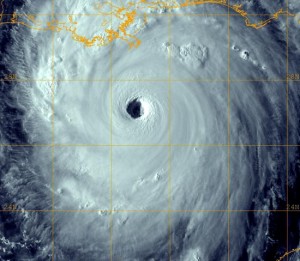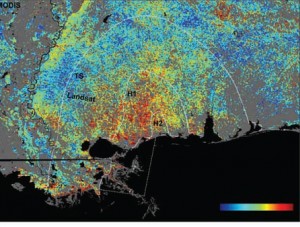
Hurricane Katrina, the 2005 storm that flooded New Orleans and pounded the Gulf coastal areas of Mississippi and Louisiana, uprooted or severely damaged roughly 320 million trees. (Image courtesy of NASA)
When we think of carbon emissions that exacerbate global climate change most of us probably think of the exhaust from automobiles and other vehicles, or smoke billowing from rows of stacks at fossil fuel-burning power plants. But there is a source of large carbon emissions that is not so immediately obvious – the destruction of forest trees through hurricanes. For example, studies led by Jeffrey Chambers, who is now with the Lawrence Berkeley National Laboratory (Berkeley Lab), have shown that Hurricane Katrina, the storm that flooded New Orleans and pounded the Gulf coastal areas of Mississippi and Louisiana, uprooted or severely damaged roughly 320 million trees. In terms of the carbon cycle, this devastating loss of vegetation from a single storm was equivalent to about a 10-percent increase in U.S. fossil fuel emissions for a year.
“Hurricanes and other extreme events that disturb forest ecosystems have the potential to alter forest structure and and ecosystem functions, including biomass accumulation rates and forest tree species composition,” says Chambers, a researcher in the Climate Sciences Department of Berkeley Lab’s Earth Sciences Division. “Quantifying these forest disturbances is necessary to evaluate the extent and severity of damage for estimating biomass loss, developing regional carbon budgets, and making management decisions.”

Berkeley Lab scientist Jeffrey Chambers is developing models that evaluate the impact of tree mortality on the carbon cycle for more accurately predicting global climate change. (Photo by Roy Kaltschmidt, Berkeley Lab Public Affairs)
Chambers, in collaboration with Berkeley Lab colleagues and researchers at other institutions, including the Los Alamos National Laboratory, the University of Maryland and Tulane University, is developing models that evaluate the impact of tree mortality on the carbon cycle. These models are designed to be incorporated into new and improved Earth Systems Models that can more accurately predict global climate change.
“Whereas other research efforts focus on the size of the area impacted by a storm, we use a combination of field plots, remote sensing image analysis, and modeling techniques to estimate the number of trees that were destroyed,” Chambers says. “This is an important advancement in the assessment of large-scale disturbances to forest ecosystems.”
Trees and other green plants are critical players in the carbon cycle, the biogeochemical process by which carbon loops between the ocean, the biosphere, the atmosphere, and Earth’s crust. Atmospheric carbon dioxide, along with water, is absorbed by green vegetation and assimilated into plant biomass. Through photosynthesis, some of the carbon is converted into sugars for the plants and the oxygen is released back into the atmosphere. When the carbon assimilated into plant biomass is greater than the carbon lost through plant decomposition, the forest serves as a valuable terrestrial carbon sink. The total sink is a net gain of one to two petagrams of carbon per year, which is the equivalent of about 25 percent of annual carbon emissions from the burning of fossil fuels.
“When a forest disturbance increases the amount of decomposing dead plant material, the ecosystem can change from a sink to a source of carbon,” Chambers says. “Processes that elevate the mortality of vegetation, especially trees, can cause a weakening of the terrestrial carbon sink that contributes to climate system warming. In addition, a warming climate increases the likelihood of extreme events that cause tree and vegetation mortality, resulting in an increase in decomposing biomass. This increase in tree and vegetation mortality could act as a positive feedback mechanism that accelerates the global warming effect.”
To quantify the destruction to forest ecosystems caused by land-falling hurricanes, Chambers and his collaborators study the numbers of downed, snapped and dead trees. These numbers are obtained by direct measurements in the field, and by regressing Landsat and Moderate Resolution Imaging Spectroradiometer (MODIS) data that in turn were associated with Forest Inventory and Analysis (FIA) data from the U.S. Forest Service. Factors such as the abundance of green vegetation, non-photosynthetic vegetation, soil and shade, recorded before and after the storm, are included to produce spatially explicit maps of hurricane forest impacts.
“The empirical models we are developing relate changes in the surface reflectance spectra to tree mortality rates, providing us with a unique method for mapping tree mortality patterns at regional to continental scales,” Chambers says. “We are working to relate these patterns to causal agents, such as wind from strong storms and hurricanes, as well as drought, insect outbreaks, and fire. Ultimately we aim to develop predictive models for how these mortality agents will change with a warming climate.”

NASA satellite image shows damaged and destroyed forest trees (in red) in the aftermath of Hurricane Katrina, damage that in terms of the carbon cycle was equivalent to a 10-percent increase in U.S. fossil fuel emissions for a year. (Image courtesy of NASA)
Chambers and his collaborators first made use of their empirical modeling techniques to assess the forest impact along the Gulf Coast as a result of hurricanes Katrina and Rita in 2005, and Hurricane Gustav, which hit the region in 2008. Their work has shown that in addition to wholesale destruction, the aftermath of these storms has led to many forests in the region being heavily invaded by Chinese tallow trees.
“In terms of biomass and carbon, it will take probably on the order of 75 to 100 years for the forests in the region to fully accumulate the carbon lost from the decomposition of all the dead trees,” Chambers says. “However, with the invasion by the Chinese tallow and other factors, the forests there will probably never be quite the same.”
Most recently, Chambers and collaborators applied their modeling technique to study Amazon tree mortality in the wake of a single squall line – an aligned cluster of convective storm cells – that spread across the entire Amazon rainforest in 2005. The widespread tree mortality caused by this one event – an estimated 540 million trees – was equivalent to nearly 25 percent of the mean annual biomass accumulation estimated for these forests.
“Our results highlight the vulnerability of Amazon trees to the wind-driven mortality associated with convective storms,” Chambers says. “Storm intensity is expected to increase with a warming climate, which would result in additional tree mortality and carbon release to the atmosphere, with the potential to further warm the climate system.”
Chambers and his collaborators also recently completed a study in which they synthesized field measurements, satellite image analyses, and empirical models to evaluate forest and carbon cycle impacts for historical hurricanes from 1851 to 2000 over the continental U.S. This study showed that an average of 97 million trees were affected each year during this time span, with an average carbon release of 25 Teragrams per year (one Teragram equals one million tons). There was twice as much destruction in the years prior to 1900 because there were more hurricanes and much larger forested areas. Although the impacts were greatest along the Gulf Coast, significant impacts also occurred in eastern North Carolina.
“The results of this study will serve as an important baseline for evaluating how potential future changes in hurricane frequency and intensity will impact forest tree mortality and carbon balance,” Chambers says.
Lawrence Berkeley National Laboratory addresses the world’s most urgent scientific challenges by advancing sustainable energy, protecting human health, creating new materials, and revealing the origin and fate of the universe. Founded in 1931, Berkeley Lab’s scientific expertise has been recognized with 12 Nobel prizes. The University of California manages Berkeley Lab for the U.S. Department of Energy’s Office of Science. For more, visit www.lbl.gov.
Additional Information
For more information about Berkeley Lab’s Climate Sciences and Carbon research visit the Website at http://esd.lbl.gov/research/programs/climate_carbon_sciences/research_areas/better_models.html